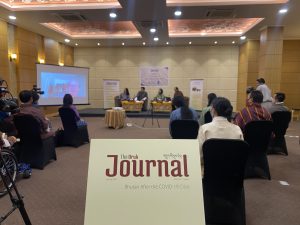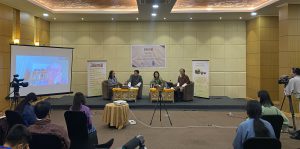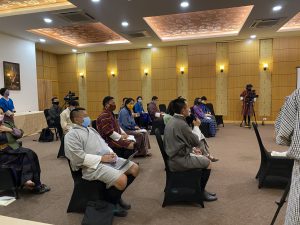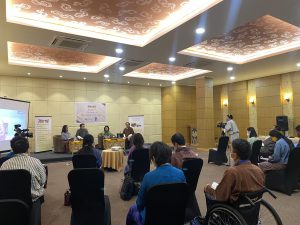Conversation Report: Bhutan After the COVID-19 Crisis
Volume 7, Issue 1 of The Druk Journal titled Bhutan After the COVID-19 Crisis was published in March 2021. 800 copies of the journal were printed. The journal consists of 15 articles from 18 different writers, both local and international, that looked at several different sectors within the society that could use this pandemic as an opportunity to reform. Almost 400 copies of the issue have been distributed so far to more than 170 different academic institutions, ministries, political parties, constitutional bodies, schools and so on across the country.

The Druk Journal (TDJ) conversation for Bhutan After the COVID-19 Crisis was held on 12 July 2021. This issue of the journal covered 16 articles that looked at several different sectors within the society that could use this pandemic as an opportunity to reform and improve. Adhering to the COVID-19 protocols, only 13 participants (7 female, 6 male) were present at the conversation which included key stakeholders from the Ministry of Education, Royal Education Council, National Council, National Commission for Women and Children, UN and the Media. To make up for the small numbers, the conversation will also be broadcast on BBS TV to ensure wider reach.
Four speakers who contributed articles to this issue of TDJ discussed the themes of anticipating areas of governance including social security, civil service, education, and health sectors. The session was moderated by the Editor of The Druk Journal, Dasho Kinley Dorji.
Public Health Expert and medical doctor, Dr Bjorn Melgaard,, who joined us from Denmark shared that with bigger countries hoarding vaccines, many countries in Africa and South Asia have been slow in vaccinating their citizens. Moreover, the health systems of many countries are not geared towards massive immunisation campaigns which will also affect how quickly vaccines can be rolled out. However, he commended Bhutan’s ability to immunise a large part of the population during the first round and also how the government was effectively using a very multi-sectoral approach to dealing with the pandemic.
Entrepreneur and Consultant, Rabsel Dorji, reminded us of the need for civil service to be agile, innovative and extremely efficient. The civil service needs to anticipate the future and be accordingly innovative. The civil service needs to also develop its capacity to implement and execute plans. He said we need to move away from the traditional approach of ‘turfism’ and working in silos to a more systems-thinking and holistic approach towards problem-solving. To achieve all of this, he noted that the public sector requires a complete change in mindset and attitude, which can be brought about through a shift in the culture of our public sector – in leadership and in education.
In answering the question about addressing the issue of working in silos, Rabsel suggested that the key is in anticipating what the future would look like and then identifying who the key drivers of change would be. He also said that the development planning process should be made consultative not just within the government agencies but also with the private sector, civil society, academia and the citizens. The implementation process should also be decentralised among the government agencies and different stakeholders.
The Executive Director of BCMD, Checho Lhamu, made a suggestion to broaden and balance the goal of education by diversifying the curricula so that it caters to a wide range of interests of the students and their potential and not just market needs. She said, “It’s not enough to produce good human beings, human beings also need to be economically productive to live a fulfilling and happy life.”
When asked about the biggest drawback in the education system, Chencho stated that the curriculum was too narrow and too much emphasis was placed on academic learning and not enough on exploring the potentials and capabilities of students. By diversifying the curriculum to cater to the student’s interests, the education system will be able to produce youth who can apply what they’ve learnt to a real-life context.
Director of Investments at the National Pension and Provident Fund, Leki Wangmo, stressed the importance for the state to provide the ageing population with an environment where they are able to retire and lead dignified lives. Although we are reaping the benefits of a demographic dividend, the population will age over time and the government needs to cater to this transition. The current national retirement system provided by NPPF only caters to 8% of the population leaving out a large part uncovered and without a secured retirement income. She suggested adopting best practices of other countries such as a multi-pillar system that covers the entire population.
When asked about the lack of preparation of the Bhutanese people for their retirement, Leki acknowledged that this lack of preparation ultimately places a burden on the Kidu system. She said that it was the perfect time for the government to think about how the country’s population is going to migrate through the different stages of life and what kind of intervention would be needed at what time.

Recommendations Summarised
Health
- Carefully assess lifting one restriction for another.
- Put in place testing systems/requirements that are rigid and well-controlled.
Education
- Broaden and balance the goal of education: diversify the curriculum to cater to the interests of the students and their potential and not just what the market needs.
- Develop technological-pedagogical-content knowledge of educators to harness the potentials of technology to transform pedagogy.
- Need a standard-based curriculum, not textbook-based.
- The curriculum is too narrow and too much emphasis is placed on academic learning and not enough on exploring children’s potential.
- Digitise education so that education is secure from future disruptions.
- Address the digital divide in society. If not, it will increase the inequality in society in terms of learning achievement.
Governance
- There is a need to be more efficient, agile and responsive as people, as a business, as a nation and as a government and form solutions that are immediate, sustainable and efficient.
- At the macro level, the governance structure needs the ability to anticipate and innovate resourcefully and build capacity to implement and execute this system properly.
- This requires structural reform, change in design, process and mechanism.
- It also requires a complete change in mindset, attitude and change in culture and mindset of the public sector.
- This change can be brought about through leadership and education.
- The leadership needs to have a clear vision, communicate that vision clearly and create a space for people to be innovative and entrepreneurial.
- Leadership cannot be complacent, leaders need to take risks to change the mindset.
- Need continuous consultation and feedback from stakeholders.
- Continuous capacity building of staff of current future challenges.
- Embedding entrepreneurship education from the primary all the way to the tertiary level so that future civil servants are equipped with the right skills, mindset and culture.
- Need to cater to citizens who now have higher expectations of service delivery; quicker, transparent and individualised.
- The government needs to move from being a provider to an enabler.
- The development planning process should be consultative not just within the government agencies but with the public sector, CSO, academia and citizens.
- The implementation process should be decentralised amongst government and ministries but also among different stakeholders.
- Open more room for Public-private partnerships which creates space for a larger ecosystem that allows for a more reformed governance structure.
- Adopt a hybrid system and contractualise civil servants positions from the director level and above.
- Invest in technology that would accelerate innovation.
- Predictive analysis and the use of data can be the key tool to anticipating the future.
- Build a solid up-to-date database.
- Social issues are interrelated; agencies need to transcend beyond thinking that we can work in isolation.
Social Security
- A high youth population means a high dependency ratio and fewer adults.
- The government needs to invest in health, education, job creation and meaningful engagement of youth so the full potential of youths is harnessed.
- The current retirement system is sectoral in design and approach – (NPPF) only caters to the public servant which is 8% of the population.
- Need a more robust and dynamic retirement system that can anticipate changes and is able to adapt to change.
- Consider increasing the retirement age because life expectancy has also increased. People can spend more time contributing to the system and less in retirement.
- The retirement system needs to be considered along with the economic development plan or the governance framework as it is costly and requires long-term planning.
- Study and adopt a multi-pillar retirement system –
- Pillar 1: a state-funded national pillar system that covers the entire population and takes a whole of population approach.
- Pillar 2: occupational retirement system that takes into account different sets of people where you contribute to get a retirement benefit at the end of your services. It is also more sustainable.
- Pillar 3: a voluntary scheme where you contribute in case you think you would need additional retirement benefits and it caters only to those who can afford it.
The conversation video is available on BCMD’s YouTube channel: https://youtu.be/cw1FcIJMszg


